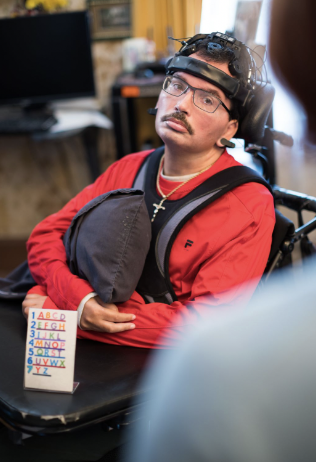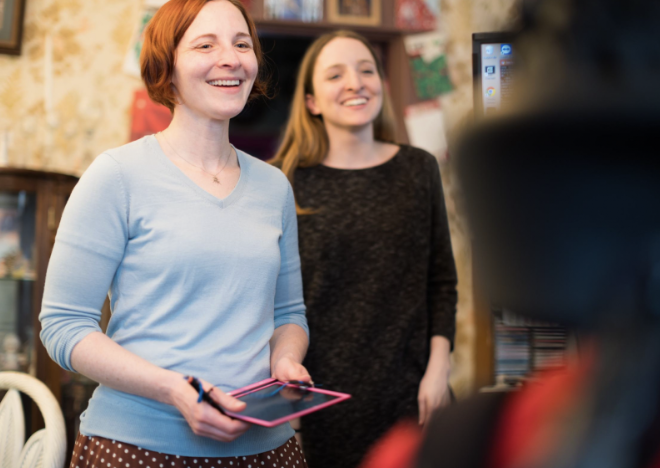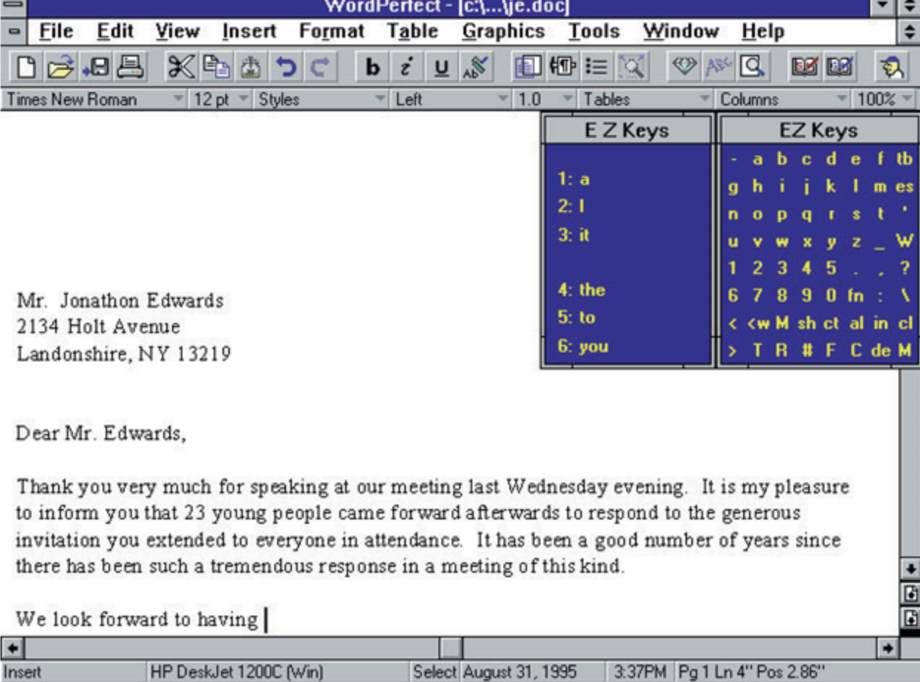Interview responses by Greg Bieker with introduction and editing by Deirdre Galvin-McLaughlin
Introduction
Greg Bieker is a skilled AAC user with over 30 years of day-to-day experiences using partner-assisted spelling. Greg started using AAC following a stroke that impacted his ability to move his body voluntarily with the exception of eye movements. The stroke did not impact his ability to form or understand complex messages.
Greg is currently a research team member of the Consortium for Accessible Multimodal Brain-Body Interfaces (https://www.cambi.tech/), a multidisciplinary team that is engineering and researching the use of brain computer interfaces for communication. A brain computer interface is a system that acquires, analyzes, and translates brain signals into commands that are relayed to a computer (Wolpaw & Wolpaw, 2012). These systems can be used by people with disabilities with limited voluntary movement to access computers and high-tech communication systems. Greg acts as a content expert on the team and offers feedback on novel assistive technology systems and participates in co-design sessions with clinical researchers to design new features. Although he has tried many high-tech systems over the years, Greg has never tried a speech-generating device that he has liked enough to use for his personal communication system.
Greg currently uses partner-assisted auditory scanning to spell messages letter-by-letter. Partner-assisted scanning is a process that involves the person communicating a message by selecting choices that are offered to them by a partner. A communication partner often offers choices by saying them out loud and the communicator will select a response by initiating a “yes” response. This “yes” response could be conventional like, nodding head for “yes” or signing “yes”, or unconventional, like doing a consistent action that means “yes” for that person.
In Greg’s personal communication system, letters are grouped and each group is delineated by a number. Partners first read through row numbers until a selection is made and then read through the letters in the group that is selected until a letter is selected. This is what is referred to as “scanning through options”. Greg consistently looks up to select the letter as his “yes” response.
Partners are provided with a visual display with numbered groupings of letters (see pictures below) and a reusable writing tablet to write messages down as they are selected by Greg. Greg doesn’t have to look at the display or reusable writing tablet to keep track of the messages he is spelling. Partners who know him really well and have lots of practice don’t have to use the display or reusable writing tablet either.

Greg spelling messages with his caregiver. They both can spell messages without needing to use any displays by using partner-assisted scanning.


Greg spelling messages with research team members, Betts Peters and Deirdre Galvin-McLaughlin during a brain computer interface experiment. The researchers use the display and a reusable writing tablet to keep track of choices and messages generated and reduce working memory demands. Greg does not have to use either to keep track of his place in the message.
Greg offers a unique perspective that higher tech isn’t always better tech! He values reliability, having a face-to-face conversation with a partner that isn’t blocked by a screen, and not having to rely on materials in his communication system. As there are more and more device systems available, this perspective is one that the community should keep in mind as user needs and opinions are the most important when designing an AAC system.
Interview with Greg Bieker
When were you first introduced to augmentative and alternative communication?
As soon as I got out of surgery 30 years ago.
Where was your communication system first introduced to you? Was it inpatient or outpatient? Did you go a long time without a communication system?
I was first introduced to my current system at Rest Harbor Rehab for the first 3 years after my accident. After a day of being at Rest Harbor a doctor showed me the system I use today. I was just asked yes or no questions at the hospital.
How did it feel to transition to using partner-assisted spelling?
I learned how to communicate with partner assisted scanning in about 20 minutes. I cried for about 3 years about my new situation.
Describe your current communication system. How do you generate messages?
I use partner assisted scanning for my communication. I direct partners via partner assisted scanning to send email and facebook messages for me.
What other communication systems have you tried over the years?
High tech eye gaze devices, brain computer interfaces (BCI), and many other high-tech systems that didn’t work for me.
Why did the other systems not work for you?
They didn’t work for me because they were very bulky and there wasn’t anybody to set them up for me and pay attention to what I was doing at Rest Harbor.
Are there things you think you wish you could change about these systems to make them work better?
Yes, I’ve thought of many problems in AAC devices I have tried. The best AAC device I’ve tried is called EZ Keys. I enjoy using EZ Keys because the scanning is the same as my partner assisted scanning system. I wish you could get to Facebook and Gmail a lot easier. I would have boxes light-up with the Facebook and Gmail symbols added to the EZ Key system.
Picture of Words+ EZ key system that Greg referenced in response as an example of technology he has tried. Retrieved from http://www.techaccess4you.com/ez-keys-software/ on 10/13/2022

Why did you choose this system over other systems that people have tried with you in the past?
No setup time or lugging around stuff with me wherever I go. Also, it’s easy to teach others and to learn how to do it.
Who are your best communication partners? Why are they so good at being a communication partner?
My caregivers and whoever spends time to learn it. Because they take the time to listen and respond to me.
Who are your worst communication partners? What is the challenge in your opinion with communicating with them?
Hospitals don’t have time to learn how to communicate with me so my caregivers have to go with me in order to translate my needs and requests.
Are there settings where communication is particularly good?
Anywhere is good for me as long as it’s quiet.
Are there settings where communication is particularly hard?
Where it’s noisy and crowded.
What do you wish you could change about your current system if you could?
More people would need to spend time with me and learn how to communicate with me.
Is there anything you would want to teach speech-language pathologists if you could?
I would like to show them what would work for me.
Is there anything you would want to teach technology developers if you could?
I would like to show them what would work for me.
Do you think you’ll ever want to use a high tech device in the future?
I’m not against high tech devices, but I haven’t been on any that have worked for me. I would use one if it worked for me. They just need to be developed better.
It is AAC awareness month, what do you wish people knew about using augmentative and alternative communication to spell messages?
I would like people to give it a try and see how easy it is to learn to communicate with people who can’t speak. I wish that they would develop a system that worked for me.
To learn more about Greg’s opinion on AAC, please watch this contribution from 2018 on the State of the Science update from the Rehabilitation Engineering Research Center on Augmentative and Alternative Communication (RERC on AAC). Greg notes that his opinion is still unchanged after 4 years and much still remains to be done to improve current AAC systems to be usable, functional, and reliable.
References
Wolpaw, J. R., & Wolpaw, E. W. (2012). Brain-Computer interfaces: Principles and practice (1st ed., Vol. 1). Oxford University Press.
